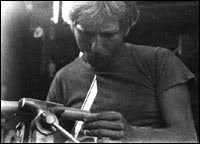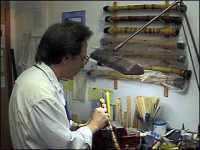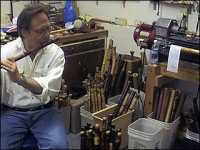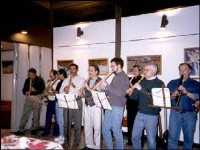Cloud Hands Music - History and Information
| Home | CDs | History | News | Flutes for Sale | ||
|
|
||||||
|
Table of Contents
Shakuhachi Recording Flute Making Shakuhachi Society Links
Peter is available for performances, private lessons, and flute making workshops.
Cloud Hands Music Peter Ross APDO 965 San Miguel de Allende, GTO 37700 Mexico Phone: 52.415.120.0793 Internet phone: 1 (720) 891-4580 email: Cloud Hands Music Shakuhachi The story of the Shakuhachi is a blend of speculation, legend, and history; so it is to the tradition itself that we must turn to discover the living thread coming through time. Doing so, we discover that the underlying spirit of the Shakuhachi is Zen. According to this tradition, the Shakuhachi was created in China in the 9th century by a follower of Zen Master Fuke as a means of continuing the sound essence of the Master's begging bell. This practice was passed into the 13th century, at which time it was transmitted to a Japanese priest studying in China who returned it to Japan. In Japan, the yet formless practice of blowing the Shakuhachi gradually became formalized, loosely at first, by flute-playing mendicant monks called Komusu or "monks of emptiness" and finally into a sect of Rinzai Zen, the Fuke-shu. By the 17th century the Fuke-shu was a recognized religious sect, using the Shakuhachi for group chanting and individual meditation. The strictly religious tradition of the Shakuhachi came to an end under the Meiji government which disbanded the Fuke-shu in 1871. Until this time the Shakuhachi had been played solely as a religious instrument. It became considered a musical instrument, an instrument of entertainment, only as the flute players merged with the general culture following the sect's prohibition. At this time classical and folk melodies were added to the religious repertoire, and the Shakuhachi became an ensemble instrument with Koto and Shamisen. The contemporary Shakuhachi student may train in both the religious and secular styles as well as join with those players attempting to merge Eastern and Western musical sounds. Teaching
Peter teaches in the traditional way. He has studied three different playing styles, Tozan-ryu, Kinko-ryu, Watazumi-do, and passes this knowledge along to his students. Peter also encourages his students to improvise and compose their own music. Private one on one instruction is available on a weekly basis. Lessons run an hour long.
Here is an article about Peter that appeared in The New Times, in April 95.
Recording Studio
Peter's ability to improvise on a wide variety of flutes and play in many moods and styles has kept him in demand as a studio musician since moving to Seattle. He has performed on soundtracks for National Geographic and Microsoft. His music has also been used for Tai Chi, Yoga and Modern Dance.
Performing
Today Peter gives concerts in Seattle, throughout the Northwest, and Hawaii. He performs each year at the Folk Life Music Festival and at the Lantern Floating Ceremony each Aug.6th on Green Lake. This ceremony is in remembrance of the victims of the bombing of Hiroshima and Nagasaki and all the victims of war and violence. Peter has performed at the Portland Japanese Gardens and the World Shakuhachi Festival in Boulder, CO.
(See calendar for complete concert schedule). He has also played with modern dance groups, at Tea houses, Japanese restaurants, private parties, and weddings. Here are some of the settings in which he has performed:

Peter in concert with koto player Bernice Hirai; Kona, Hawaii Sept. 2002 Peter's performance dates can be located in the calendar section. Peter is also available for lecture-demonstrations. Contact Cloud Hands Music for booking arrangements. Flute Making
Craft Shows
Seattle Shakuhachi Society
The Seattle Shakuhachi Society was formed in 1996. The goal is to keep the spirit of the shakuhachi alive in Seattle. The society arranges concerts, master classes and private lessons by local and out of state performers. After Peter left Seattle, the Society formed its own web site and electronic mailing list to keep its members informed of new events.
Links
The International Shakuhachi Society, valuable info on people, pieces, albums, and more.
Tai Hei Shakuhachi Flutes Monty Levenson's online store of things shakuhachi related. Todd Barton Todd has a great list of other shakuhachi sites. Kinya Sogawa, a shakuhachi performer and maker. Ray Brooks, musician and author of "Blowing Zen" and "Hollow Bell". Tom Deaver, an accomplished shakuhachi maker. Marco Lienhard, a fine shakuhachi player. Japanese Gardens Web site for the Japanese Gardens. Page Revised 1/5/2007 |
||||||||||||||||||||









